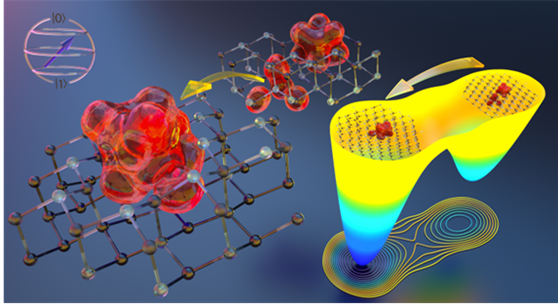Reviewed by Lexie CornerJun 11 2024
An international group of researchers from the Argonne National Laboratory and the University of Chicago constructed advanced computer simulations and a new technique to discover how defects in a promising semiconductor material (silicon carbide) can create quantum bits (qubits). This finding could be crucial for developing future quantum computers. This study was published in the journal Nature Communications.
 Artist’s representation of the formation pathway of vacancy complexes for spin-based qubits in the silicon carbide host lattice and, to the right, the associated energy landscape. Image Credit: University of Chicago.
Artist’s representation of the formation pathway of vacancy complexes for spin-based qubits in the silicon carbide host lattice and, to the right, the associated energy landscape. Image Credit: University of Chicago.
The Science
Unlike classical bits found in standard computers, quantum bits, or qubits, are used in quantum computing. Qubits can simultaneously exist in a mixture of the probabilities of both values, whereas conventional bits can only have the values 0 or 1. This makes quantum computing incredibly potent for issues that traditional computers struggle to solve.
To construct large-scale quantum computers, scientists must learn how to design and manipulate materials that can be produced on an industrial scale. Qubit materials that show great promise are semiconductors.
Computer chips found in computers, mobile phones, medical devices, and other applications are already made of semiconductors. Certain atomic-scale defects, called vacancies, in the semiconductor silicon carbide (SiC) show promise as qubits. However, knowledge of how to generate and control these defects remains limited.
The Impact
Quantum computing could transform the way we answer complex questions. Existing small-scale quantum computers have provided a preview of the technology's potential. To construct and operate large-scale quantum computers, researchers must learn how to control qubits composed of materials that make sense economically and technically.
The study determined the stability and chemical processes needed to produce the appropriate vacancies for qubits and ascertain their electrical properties. These developments will speed up the creation of next-generation large-scale quantum computers and quantum sensors by enabling the design and construction of spin-based qubits in semiconductor materials with atomic precision.
Summary
Researchers must deploy large-scale quantum computers, ideally capable of running at ambient temperature, to facilitate the next quantum information science revolution. The achievement of this objective depends on the realization and control of qubits in relevant industry materials.
In the work presented here, scientists used a variety of theoretical techniques to examine qubits constructed from vacancies in SiC. Up until now, researchers have known nothing about how to manage and design the process of selective formation for the voids. The most challenging problems for theory and simulations are the involved barrier energies for vacancy migration and combination.
This study by researchers at the Department of Energy's (DOE) Midwest Center for Computational Materials (MICCoM) used a combination of cutting-edge materials simulations and neural-network-based sampling to find the atomistic mechanism of qubit generation from spin defects in a wide-bandgap semiconductor.
The group demonstrated the qubit creation process in SiC, a semiconductor with great promise due to its long qubit coherence durations, all-optical spin initiation, and read-out capabilities.
One of the nation's DOE Computational Materials Sciences centers, MICCoM creates cutting-edge, open-source software tools to assist scientists in simulating, modeling, and forecasting the basic characteristics and behavior of functional materials. Researchers from the University of Chicago and Argonne National Laboratory are working on this project.
Funding
This research was funded by the Department of Energy (DOE) Office of Science, Office of Basic Energy Sciences, Materials Sciences and Engineering Division and is part of the Basic Energy Sciences Computational Materials Sciences Program in Theoretical Condensed Matter Physics.
The computationally demanding simulations used several high-performance computing resources: Bebop in Argonne National Laboratory’s Laboratory Computing Resource Center; the Argonne Leadership Computing Facility (ALCF), a DOE Office of Science user facility: the University of Chicago’s Research Computing Center.
The team also received access to ALCF computing resources through DOE’s Innovative and Novel Computational Impact on Theory and Experiment (INCITE) program. NIH provided additional support.
Journal Reference:
Lee, E. M. Y., et. (2021) Stability and molecular pathways to the formation of spin defects in silicon carbide. Nature Communications. doi.org/10.1038/s41467-021-26419-0